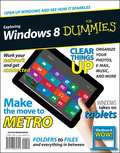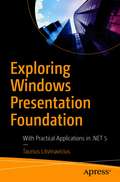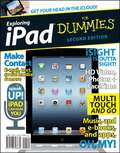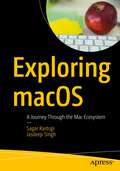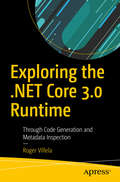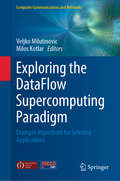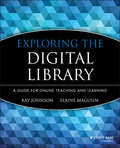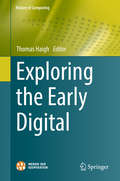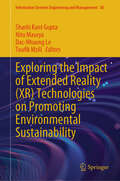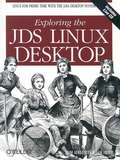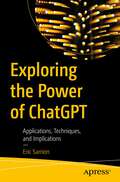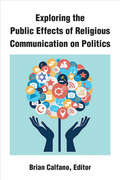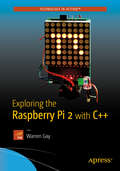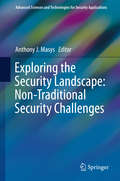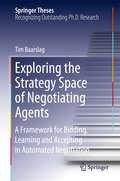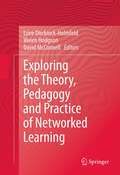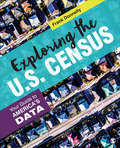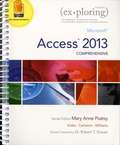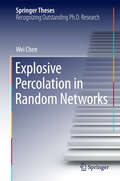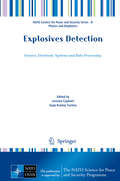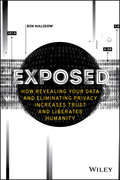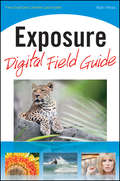- Table View
- List View
Exploring Windows 8 For Dummies
by Galen GrumanGet up to speed on Windows 8!Exploring Windows 8 For Dummies packs 168 pages of magazine-style articles, lavish illustrations, and great tips into an eye-catching publication that shows you how to use the new Windows 8 operating system from start to finish. Explore new features, like the touchscreen-style interface, a big change from the classic Windows look and feel. Ideal for the reader who is already familiar with the Windows operating system, but just needs the basics on the move to Windows 8, you'll also discover new apps, new ways to handle traditional tasks, and much more.Helps readers get up to speed quickly and get the most out of the new Windows 8 operating systemBreaks down Windows 8 features and functions into a series of magazine-style spreads that offer full-color illustrations and step-by-step instructionOffers a value-priced helping hand to readers who want the basics of Windows 8Covers new Windows 8 features, getting e-mail and getting online, organizing pictures, exploring the app market, networking, printing, troubleshooting, and moreExplore Windows 8 and enjoy the ride with this fun and unique new guide.
Exploring Windows Presentation Foundation: With Practical Applications in .NET 5
by Taurius LitvinaviciusUse the Windows Presentation Foundation (WPF) technology to develop Windows applications using C# and XAML for design. This book will get you through not only the basics, but also some of the more advanced concepts of WPF in .NET 5. The book starts with basic concepts such as window, page, text box, and message box as well as a sequence of common events and event handling in WPF. You will learn how to use various elements in WPF and deal with them in .NET 5. You will understand how to work with files and access them in WPF along with binding and MVVM (Model-View-View-Model). You will learn how to retrieve data from APIs, work in XAML, and understand where design and style properties should be applied in WPF.After reading this book you will be able to work on WPF and apply its concepts in .NET 5, .NET core, and the .NET framework.What You Will LearnUnderstand the basics of WPF: click event, inputs, and general setupWork with WPF interface events and handlingKnow how file handling works in WPFRetrieve data from APIs in a modern wayWho This Book Is ForDevelopers with basic knowledge of C#.
Exploring iPad For Dummies
by Galen GrumanGet to know the incredible iPad in a uniquely different Dummies format!The iPad combines the best of your favorite gadgets into one amazing ultraportable touch device. And, thisone-of-a-kind For Dummies guide is your is your ticket for making the most out of your iPad or iPad 2. Thoroughly updated for the third-generation iPad, the new edition of this informative, full-color guide is packed with tidbits, full-color graphics, informative articles, and easy-to-follow step lists. Now that you have a new iPad, get to know it a little better with Exploring iPad For Dummies 2nd Edition.Includes coverage of the third-generation iPad, iPad 2, and the original iPadHelps you get connected, stay in touch with social media, text with iMessage, play slideshows or music, curl up with your favorite e-book, and find the latest and greatest apps for any interestShows you how to get organized with calendars, contacts, and Reminders; take notes; locate where you are or where you're going with Maps; stream content; or go hands-free with DictationAlso covers video-chatting with FaceTime, recording HD videos, and capturing and editing photos on the incredible retina displayYou've got the magic touch for all things iPad with Exploring iPad For Dummies 2nd Edition by your side.
Exploring macOS: A Journey Through the Mac Ecosystem
by Sagar Rastogi Jasdeep SinghIf you are a new to the Apple macOS ecosystem and want to get started using it for your enterprise, this is the book for you. You will learn how to navigate the Mac operating system, including an introduction to macOS and its fundamentals, management settings, reinstallation process, and usability. The book also provides tutorials which can be used for troubleshooting networks, configuration, and to ease Windows users’ transition to the Mac world. Additionally, it provides detailed information about managing Mac devices using Jamf Pro within organizations, as well as basic and advanced automation scripting. By the time you finish Apple Enterprise Management, you will have a detailed understanding of macOS and its functionality, how to manage Mac devices for enterprise use, and the role Jamf Pro plays in managing and securing Mac devices effectively whilse providing a seamless user experience. What You Will Learn Perform administrative tasks on macOS devicesImplement macOS in an enterprise settingUnderstand the differences between various operating systems, particularly macOS and WindowsManage network configuration and its servicesManage Apple macOS devices using Jamf Pro, a stable, robust, and renowned enterprise mobility management toolGet started with Bash (shell) scripting to automate tasks Who Is This Book For: Helpdesk consultants, remote desktop support professionals, system engineers, macOS Apple desktop administrators, enterprise Apple macOS desktop architects, Jamf system engineers, and digital workplace engineers.
Exploring the .NET Core 3.0 Runtime: Through Code Generation and Metadata Inspection
by Roger VillelaExplore advanced .NET APIs and create a basic .NET core library with dynamic code generation and metadata inspection to be used by other libraries or client applications. This book starts with the benefits of .NET including its fundamental tasks and tools where you will learn .NET SDK tools and the ILDasm tool. This is followed by a detailed discussion on code generation in .NET API programming. Along the way, you will learn how to build a programming model through a code-generator tool and metadata inspector tool using .NET version information for .NET assembly and binary code. Exploring the .NET Core 3.0 Runtime covers the features of Microsoft Visual Studio 2019 using a tutorial and shows you how to create a .NET Core 3.0 application. Here you will configure and deploy your .NET projects along with meta packages and see some do's and don'ts. Finally, you will compare the features of .NET Core 3.0 with the .NET Framework library and its GUI frameworks. After reading this book, you will be able to work in a .NET 3.0 environment and program for its two advanced features: code generation and metadata inspection. What You Will LearnUnderstand the inner workings of an assembly’s structural organizationWork with reflection through the .NET Core platformCarry out dynamic code generation using the .NET Core API's code document model (CodeDOM) Use the metadata mechanism of the .NET Core platformWho This Book Is ForSoftware developers and engineers using .NET and/or the .NET Core platform and tools.
Exploring the DataFlow Supercomputing Paradigm: Example Algorithms for Selected Applications (Computer Communications and Networks)
by Veljko Milutinovic Milos KotlarThis useful text/reference describes the implementation of a varied selection of algorithms in the DataFlow paradigm, highlighting the exciting potential of DataFlow computing for applications in such areas as image understanding, biomedicine, physics simulation, and business.The mapping of additional algorithms onto the DataFlow architecture is also covered in the following Springer titles from the same team: DataFlow Supercomputing Essentials: Research, Development and Education, DataFlow Supercomputing Essentials: Algorithms, Applications and Implementations, and Guide to DataFlow Supercomputing.Topics and Features: introduces a novel method of graph partitioning for large graphs involving the construction of a skeleton graph; describes a cloud-supported web-based integrated development environment that can develop and run programs without DataFlow hardware owned by the user; showcases a new approach for the calculation of the extrema of functions in one dimension, by implementing the Golden Section Search algorithm; reviews algorithms for a DataFlow architecture that uses matrices and vectors as the underlying data structure; presents an algorithm for spherical code design, based on the variable repulsion force method; discusses the implementation of a face recognition application, using the DataFlow paradigm; proposes a method for region of interest-based image segmentation of mammogram images on high-performance reconfigurable DataFlow computers; surveys a diverse range of DataFlow applications in physics simulations, and investigates a DataFlow implementation of a Bitcoin mining algorithm.This unique volume will prove a valuable reference for researchers and programmers of DataFlow computing, and supercomputing in general. Graduate and advanced undergraduate students will also find that the book serves as an ideal supplementary text for courses on Data Mining, Microprocessor Systems, and VLSI Systems.
Exploring the Digital Library
by Johnson Elaine Kay MagusinExploring the Digital Library, a volume in The Jossey-Bass Online Teaching and Learning series, addresses the key issue of library services for faculty and their students in the online learning environment. Written by librarians at Athabasca University, a leading institution in distance education, this book shows how faculty can effectively use digital libraries in their day-to-day work and in the design of electronic courses. Exploring the Digital Library is filled with information, ideas, and Discusses how information and communication technologies are transforming scholarship communication Provides suggestions for integrating digital libraries into teaching and course development Describes approaches to promoting information literacy skills and integrating these skills across the curriculum Outlines the skills and knowledge required in digital library use Suggests opportunities for faculty and librarians to collaborate in the online educational environment
Exploring the Early Digital (History of Computing)
by Thomas HaighChanges in the present challenge us to reinterpret the past, but historians have not yet come to grips with the convergence of computing, media, and communications technology. Today these things are inextricably intertwined, in technologies such as the smartphone and internet, in convergent industries, and in social practices. Yet they remain three distinct historical subfields, tilled by different groups of scholars using different tools. We often call this conglomeration “the digital,” recognizing its deep connection to the technology of digital computing. Unfortunately, interdisciplinary studies of digital practices, digital methods, or digital humanities have rarely been informed by deep engagement with the history of computing.Contributors to this volume have come together to reexamine an apparently familiar era in the history of computing through new lenses, exploring early digital computing and engineering practice as digital phenomena rather than as engines of mathematics and logic. Most focus on the period 1945 to 1960, the era in which the first electronic digital computers were created and the computer industry began to develop. Because digitality is first and foremost a way of reading objects and encoding information within them, we are foregrounding topics that have until now been viewed as peripheral in the history of computing: betting odds calculators, card file systems, program and data storage, programmable calculators, and digital circuit design practices. Reconceptualizing the “history of computing” as study of the “early digital” decenters the stored program computer, repositioning it as one of many digital technologies.
Exploring the Earth with QGIS: A Guide to Using Satellite Imagery at Its Full Potential (Springer Remote Sensing/Photogrammetry)
by Fatwa RamdaniWith the rapid advancements in satellite technology, earth remote sensing has become an indispensable tool for a wide range of applications, from environmental monitoring to disaster management. However, the vast amount of data generated by these satellites can be overwhelming for many researchers and practitioners who lack the necessary skills and tools to process and analyze it. This is where QGIS comes in. QGIS is a powerful, open-source Geographic Information System (GIS) software that has been extensively used in the field of earth remote sensing. It provides a user-friendly platform for processing, analyzing, and visualizing satellite imagery, enabling users to unlock the full potential of earth remote sensing data. The purpose of this book is to help researchers and practitioners who lack the necessary skills and tools to process and analyze satellite imagery using QGIS. There are several books that cover the use of QGIS for earth remote sensing, but most of them are either too technical or too general. This book fills this gap by providing a comprehensive and user-friendly guide to using QGIS for earth remote sensing applications. It includes a range of real-world case studies that demonstrate the power and versatility of QGIS for solving complex problems in earth remote sensing. This will provide readers with practical examples of how to use QGIS for earth remote sensing and inspire them to explore new applications and possibilities. The book is intended for GIS professionals, students (undergraduate and graduate), and researchers who are interested in using QGIS for earth remote sensing applications. It will be particularly useful for those who are new to QGIS or who want to expand their knowledge of the software for remote sensing purposes.
Exploring the Impact of Extended Reality (Information Systems Engineering and Management #38)
by Dac-Nhuong Le Shashi Kant Gupta Nitu Maurya Toufik MziliThis book offers a groundbreaking exploration of how Extended Reality (XR) technologies can drive environmental sustainability. By integrating virtual, augmented, and mixed realities, it provides innovative solutions to enhance understanding and inspire action on environmental issues. The text is meticulously curated to cover the multifaceted applications of XR, from revolutionizing environmental practices with deep learning to leveraging quantum computing for sustainable solutions. It highlights the synergy between XR and artificial intelligence in optimizing supply chains and enhancing data analytics. Aimed at researchers, practitioners, and policymakers, this resource underscores the critical role of XR in environmental advocacy, emphasizing its potential in effective communication and behavior change. The book also delves into immersive education, fostering a culture of environmental stewardship through experiential learning. Ultimately, it calls for interdisciplinary collaboration to address pressing environmental challenges, envisioning a future where XR technologies are pivotal in safeguarding our planet.
Exploring the JDS Linux Desktop
by Tom Adelstein Sam HiserThe Java Desktop System (TM), from Sun Microsystems, is a modern system for all kinds of users, novice through expert. As an unusually robust, well-integrated desktop system, it may become the first to fulfill the promise of mass adoption for open source. JDS brings Linux and other open source software up to a level of usability that makes them suitable for the enormous base of Personal Computer users including office workers, students, mobile and home users. It behaves pretty much the way a Windows or Mac user would expect, but with many more powerful features. JDS has seen widespread adoption in the United States, Britain, China, and elsewhere. This book is the ideal guide to JDS: it is clear and direct, but loaded with insights from authors who have spent time working with, supporting, and enhancing the system. Tom Adelstein is an award winning polymath system designer; Sam Hiser is a respected business consultant with an itch that led him to become the marketing project lead for OpenOffice.org. Both are advocates for open source and founders of the Open Government Interoperability Project, members of the Open Source Software Institute and contributors to the JDShelp.org project. This book carefully covers such housekeeping chores as setting up networking, updates, and backups. Then it enters into great depth concerning the key productivity tools every user needs: email, web browsing, instant messaging, word processing, spreadsheets, and slide presentations. A number of chapters and appendices concerning useful tools, including things you can add to your system, rounds out this remarkably useful book. It has plenty to offer the new user as well as the seasoned Linux professional.
Exploring the Power of ChatGPT: Applications, Techniques, and Implications
by Eric SarrionLearn how to use the large-scale natural language processing model developed by OpenAI: ChatGPT. This book explains how ChatGPT uses machine learning to autonomously generate text based on user input and explores the significant implications for human communication and interaction.Author Eric Sarrion examines various aspects of ChatGPT, including its internal workings, use in computer projects, and impact on employment and society. He also addresses long-term perspectives for ChatGPT, including possible future advancements, adoption challenges, and considerations for ethical and responsible use. The book starts with an introduction to ChatGPT covering its versions, application areas, how it works with neural networks, NLP, and its advantages and limitations. Next, you'll be introduced to applications and training development projects using ChatGPT, as well as best practices for it. You'll then explore the ethical implications of ChatGPT, such as potential biases and risks, regulations, and standards. This is followed by a discussion of future prospects for ChatGPT. The book concludes with practical use case examples, such as text content creation, software programming, and innovation and creativity.This essential book summarizes what may be one of the most significant developments in artificial intelligence in recent history and provides useful insights for researchers, policymakers, and anyone interested in the future of technology.What You Will LearnUnderstand the basics of deep learning and text generation using language models such as ChatGPTPrepare data and train a language model to generate textUse ChatGPT for various applications such as marketing text generation or answering questionsUnderstand the use of ChatGPT through the OpenAI API and how to optimize model performanceWho This Book Is ForSoftware developers and professionals, researchers, students, and people interested in learning more about this field and the future of technology.
Exploring the Public Effects of Religious Communication on Politics
by Brian CalfanoThough not all people are religious believers, religion has played important historic roles in developing political systems, parties, and policies—affecting believers and nonbelievers alike. This is particularly true in the United States, where scholars have devoted considerable attention to a variety of political phenomena at the intersection of religious belief and identity, including social movements, voting behavior, public opinion, and public policy. These outcomes are motivated by “identity boundary-making” among the religiously affiliated. The contributors to this volume examine two main factors that influence religious identity: the communication of religious ideas and the perceptions of people (including elites) in communicating said ideas. Exploring the Public Effects of Religious Communication on Politics examines an array of religious communication phenomena. These include the media’s role in furthering religious narratives about minority groups, religious strategies that interest groups use to advance their appeal, the variable strength of Islamophobia in cross-national contexts, what qualifies as an “evangelical” identity, and clergy representation of religious and institutional teachings. The volume also provides ways for readers to think about developing new insights into the influence religious communication has on political outcomes.
Exploring the Raspberry Pi 2 with C++
by Warren GayYou have a Pi 2, but what exactly can you do with it? This book takes you on a tour of the Pi 2 hardware and all of the fantastic things that you can do to create innovative and useful projects with your Pi. Start with creating a workstation that does actual work, and move into installing a custom kernel, creating a clock, learning the ins and outs of the GPIO interface, and pick up some useful C++ skills along the way. Warren Gay, author of Mastering the Raspberry Pi, takes you through a set of experiments to show just what the Pi 2 is capable of and how you can use it to make your own fantastic creations. What you'll learn How to create an experimenter's workstation for the Pi 2, complete with breadboard and even Arduino All the details of GPIO, including a custom command for working with it Useful projects like a general purpose clock and the PiSpy Quick intro to C++ for the Pi How to make a multi-core webserver Who this book is for Intermediate electronics enthusiasts and Pi fans, makers, students, teachers, and everyone who wants to know how to make the Pi really work. Table of Contents Chapter 1: Introduction to Raspberry Pi 2 Chapter 2: Building Your Pi 2 Experimental Workstation Chapter 3: Installing Software for Experiments Chapter 4: Warming up with GPIO Chapter 5: Using the PWM Peripheral Chapter 6: Building a "Matrix" Display for CPU Usage Chapter 7: Using General Purpose Clocks to Send FM Signals Chapter 8: Debouncing Chapter 9: Morse Code Decoder Chapter 10: Converting Digital to Analog Chapter 11: Converting Analog to Digital Chapter 12: Building an RF Transmitter and Receiver Chapter 13: Linking the Pi to AVR or Arduino
Exploring the Security Landscape: Non-Traditional Security Challenges
by Anthony J. MasysThis bookprovides international perspective for those studying or working in thesecurity domain, from enforcement to policy. It focuses on non-traditionalthreats in a landscape that has been described as transnational in nature andincorporates natural disasters, gang violence, extremism and terrorism, amongstother issues. Chapters provide innovative thinking on themes includingcyber security, maritime security, transnational crime, human security,globalization and economic security. Relevanttheoretical frameworks are presented and readers are expertly guided throughcomplex threats, from matters pertaining to health security which pose threats notonly to humans but also have significant national security implications, toissues regarding critical infrastructure vulnerability and the complexity ofunderstanding terrorist operations. Authors reveal how emerging uncertaintiesregarding global critical infrastructure and supply chain security, foodsecurity, and health security are linked to the notion of human security. Securityprofessionals, policy makers and academics will all gain from the insights,strategies and perspectives in this book. It builds understanding of thedeepening and broadening domain of security studies and provides a valuablereference text for courses on security studies and international relations.
Exploring the Strategy Space of Negotiating Agents
by Tim BaarslagThis book reports on an outstanding thesis that has significantlyadvanced the state-of-the-art in the area of automated negotiation. It givesnew practical and theoretical insights into the design and evaluation ofautomated negotiators. It describes an innovative negotiating agent frameworkthat enables systematic exploration of the space of possible negotiationstrategies by recombining different agent components. Using this framework, newand effective ways are formulated for an agent to learn, bid, and accept duringa negotiation. The findings have been evaluated in four annual instantiationsof the International Automated Negotiating Agents Competition (ANAC), theresults of which are also outlined here. The book also describes severalmethodologies for evaluating and comparing negotiation strategies andcomponents, with a special emphasis on performance and accuracy measures.
Exploring the Theory, Pedagogy and Practice of Networked Learning
by David Mcconnell Lone Dirckinck-Holmfeld Vivien HodgsonThis book will be based on a selection of high quality research papers presented at the Networked Learning Conference, May3-4, 2010. The Networked Learning Conference is an international, research-based conference. Since its inception in 1998 the conference has developed a strong following by international researchers. In addition it is well supported by practitioners, managers and learning technologists interested in contributing to and hearing about research in this area. The conference is considered a major event in the international 'technology enhanced learning' conference circuit. This edited volume presents cutting edge research that will explore current trends and advances in research on networked learning, technology enhanced learning and e-learning.
Exploring the U.S. Census: Your Guide to America’s Data
by Francis P. DonnellyExploring the U.S. Census gives social science students and researchers alike the tools to understand, extract, process, and analyze data from the decennial census, the American Community Survey, and other data collected by the U.S. Census Bureau. Donnelly′s text provides a thorough background on the data collection methods, structures, and potential pitfalls of the census for unfamiliar researchers, collecting information previously available only in widely disparate sources into one handy guide. Hands-on, applied exercises at the end of the chapters help readers dive into the data. Along the way, the author shows how best to analyze census data with open-source software and tools. Readers can freely evaluate the data on their own computers, in keeping with the free and open data provided by the Census Bureau. By placing the census in the context of the open data movement, this text makes the history and practice of the census relevant so readers can understand what a crucial resource the census is for research and knowledge.
Exploring the U.S. Census: Your Guide to America’s Data
by Francis P. DonnellyExploring the U.S. Census gives social science students and researchers alike the tools to understand, extract, process, and analyze data from the decennial census, the American Community Survey, and other data collected by the U.S. Census Bureau. Donnelly′s text provides a thorough background on the data collection methods, structures, and potential pitfalls of the census for unfamiliar researchers, collecting information previously available only in widely disparate sources into one handy guide. Hands-on, applied exercises at the end of the chapters help readers dive into the data. Along the way, the author shows how best to analyze census data with open-source software and tools. Readers can freely evaluate the data on their own computers, in keeping with the free and open data provided by the Census Bureau. By placing the census in the context of the open data movement, this text makes the history and practice of the census relevant so readers can understand what a crucial resource the census is for research and knowledge.
Exploring: Microsoft Access 2013, Comprehensive
by Robert T. Grauer Cynthia Krebs Maryanne Poatsy Eric Cameron Jerri WilliamsThis book offers full, comprehensive coverage of Access. Move students beyond the point-and-click. The goal of the Exploring series is to move students beyond the point and click, to understanding the why and how behind each skill. And, because so much learning takes place outside of the classroom, this series provides learning tools that students can access anywhere, any time. Students go to college now with a different set of skills than they did years ago. With this in mind, the Exploring series seeks to move students beyond the basics of the software at a faster pace, without sacrificing coverage of the fundamental skills that everyone needs to know. NOTE: Before purchasing, check with your instructor to ensure you select the correct ISBN. Several versions of Pearson's MyLab & Mastering products exist for each title, and registrations are not transferable. To register for and use Pearson's MyLab & Mastering products, you may also need a Course ID, which your instructor will provide. Used books, rentals, and purchases made outside of Pearson If purchasing or renting from companies other than Pearson, the access codes for Pearson's MyLab & Mastering products may not be included, may be incorrect, or may be previously redeemed. Check with the seller before completing your purchase.
Explosive Percolation in Random Networks
by Wei ChenThis thesis is devoted to the study of the Bohman-Frieze-Wormald percolation model, which exhibits a discontinuous transition at the critical threshold, while the phase transitions in random networks are originally considered to be robust continuous phase transitions. The underlying mechanism that leads to the discontinuous transition in this model is carefully analyzed and many interesting critical behaviors, including multiple giant components, multiple phase transitions, and unstable giant components are revealed. These findings should also be valuable with regard to applications in other disciplines such as physics, chemistry and biology.
Explosives Detection: Sensors, Electronic Systems and Data Processing (NATO Science for Peace and Security Series B: Physics and Biophysics)
by Lorenzo Capineri Eyüp Kuntay TurmuşThis volume presents selected contributions from the “Advanced Research Workshop on Explosives Detection” hosted by the Department of Information Engineering of the University of Florence, Italy in 2018. The main goal of the workshop was to find out how Science for Peace and Security projects in the field of Explosives Detection contribute to the development and/or refinement of scientific and technical knowledge and competencies. The findings of the workshop, presented in the last section of the book, determine future actions and direction of the SPS Programme in the field of explosives detection and management.The NATO Science for Peace and Security (SPS) Programme, promotes dialogue and practical cooperation between NATO member states and partner nations based on scientific research, technological innovation and knowledge exchange. Several initiatives were launched in the field of explosive detection and clearance, as part of NATO’s enhanced role in the international fight against terrorism. Experts and scientists from NATO members and partner countries have been brought together in multi-year projects, within the framework of the SPS Programme, to cooperate in the scientific research in explosive detection field, developing new technologies and methods to be implemented in order to detect explosive substances in different contexts.
Exposed: How Revealing Your Data and Eliminating Privacy Increases Trust and Liberates Humanity
by Ben MalisowDiscover why privacy is a counterproductive, if not obsolete, concept in this startling new book It's only a matter of time-- the modern notion of privacy is quickly evaporating because of technological advancement and social engagement. Whether we like it or not, all our actions and communications are going to be revealed for everyone to see. Exposed: How Revealing Your Data and Eliminating Privacy Increases Trust and Liberates Humanity takes a controversial and insightful look at the concept of privacy and persuasively argues that preparing for a post-private future is better than exacerbating the painful transition by attempting to delay the inevitable. Security expert and author Ben Malisow systematically dismantles common notions of privacy and explains how: Most arguments in favor of increased privacy are wrong Privacy in our personal lives leaves us more susceptible to being bullied or blackmailed Governmental and military privacy leads to an imbalance of power between citizen and state Military supremacy based on privacy is an obsolete concept Perfect for anyone interested in the currently raging debates about governmental, institutional, corporate, and personal privacy, and the proper balance between the public and the private, Exposed also belongs on the shelves of security practitioners and policymakers everywhere.
Exposing the Clinton Addiction to Power
by Fred LucasThe subject of FBI investigations and the leaders of the most controversial political organization in America, the Clintons have long been the subject of talk radio. Fred Lucas opens up those conversations that tore open the secrets currently being examined by the FBI. For those interested in the dynamics of Washington politics, the undercurrents of the Establishment and the lust for power that moves those who practice politics in Washington today, Fred Lucas brings those readers into the mix.
Exposure Digital Field Guide
by Alan HessSecrets of exposure revealed, with a bonus color checker card includedExposure is the number one topic that digital photographers want to know about. This full-color book fits in your camera bag and provides all the information you need on this very important aspect of digital photography.Exposure involves combining ISO, aperture, and shutter speed in different variations to accomplish your vision of the perfect image. Exposure Digital Field Guide takes you through the complex techniques of good exposure, taking you from hobbyist to serious amateur photographer.Explains how to adjust shutter speed and aperture to control the amount of light hitting the camera's light sensorTeaches you how to "see the light" for the perfect exposureHelps you gain confidence as you move from automatic controls into manipulating the elements of exposure for specific resultsPacked with stunning full-color photographs to illustrate what you can achieveProvides suggested settings for various shooting situations and subjectsIncludes a tear-out color checker card to help you maintain true colorFits in your camera bag for ready reference in the fieldExposure Digital Field Guide helps you master one of the most complex and intricate elements of digital photography.
